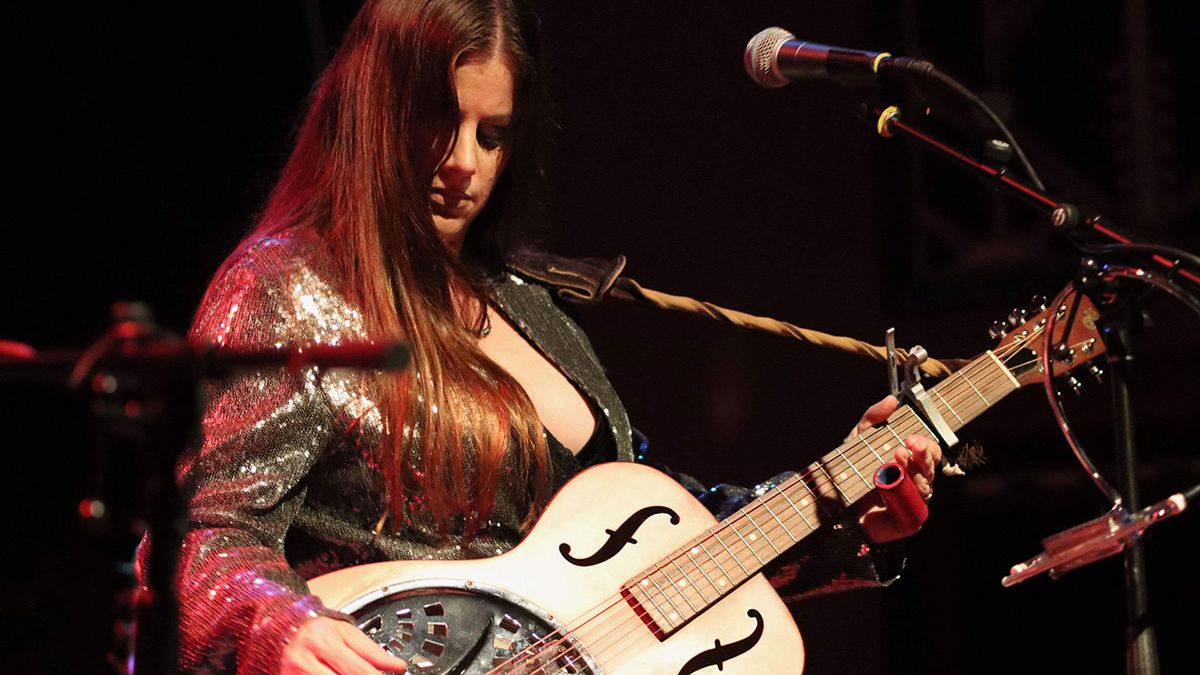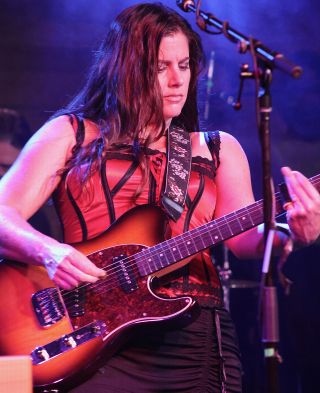“The Robert Cray gigs had me shaking so badly that I thought I’d faint… It was one of the pools I had to dive into or drown”: A non-shredder among metal guitarists, Katie Knipp took years to go electric – then scored a hit blues album
Inspired to explore blues by a choir singing Mozart, Knipp avoided asking advice from the big names she opened for – and even though it took 20 years, the G&L player has made it her own way

After four studio albums and two EPs, Katie Knipp reached No. 9 on the Billboard Blues Album chart in 2022 with Live at the Green Room Social Club. Her latest studio release, Me, did even better, reaching No. 5 on the same chart.
After 20-plus years, a couple of kids, and nearly giving up music for a 9-to-5, it’s been a long road . “I knew I was choosing a more challenging life path by doing this,” Knipp tells Guitar World. “But I had to follow my heart.”
Describing herself as a late bloomer, she didn’t pick up guitar until college, when her love for blues sent her in search of “more of an instant rhythm.” She explains: “Blues was a style I always loved. I remember throwing myself onstage after only playing for a few months, strumming the chords and singing.”
Embracing her passion for writing songs, she released Violent In Here in 2003, followed by 2005’s Take Her Down, 2010’s Midnight Mind and 2018’s Take It With You. “I know I have a ton to learn,” she says. “I’m the type of player that learns a nugget and immediately writes a song around that.
“My purpose is always to write songs with the things I learn. I’m always tweaking my sound, especially since I got my G&L electric guitars. I only recently went electric; I have to credit Pancho Tomaselli – my music partner, bassist and co-producer – for saving me time by finding the right sounds with my amp.”
One of the lessons Knipp has learned she says, is: “Lean into your gifts and trust them. We should never be apologetic about them. When I was opening act for the famous folks, audiences appreciated that I was different. I hope other acts on a bill aren’t copying each other in any way.”
Meanwhile, she’s continuing work on new riffs. “I want to express myself on guitar as deeply as I do when I sing,” she explains. “This process feels endless.”
Get The Pick Newsletter
All the latest guitar news, interviews, lessons, reviews, deals and more, direct to your inbox!
What player was your biggest inspiration?
“Bonnie Raitt has always influenced me with her slide work and all-around career, and Son House also influenced me with his slide playing. I don’t consider myself a shredder; I admire players as a listener, like David Rawlings, Molly Tuttle, Stevie Ray Vaughan and Eric Gales. I adore Robert Randolph’s playing, too.”
Growing up in California, what was your local music scene like?
“Metal – straight out of Concord, with folks like Jack Gibson of Exodus in my band at certain stages. I remember opening solo for metal bands many times, even though my style was definitely not that. They were very nice, welcoming and encouraging. I cut my teeth in Berkeley, since it was only 30 minutes away and it had more of a blues scene.”
So many electric guitars from other brands and players were so treble-tastic thin to me that I shied away from playing electric entirely
Can you remember your first guitar?
“It was a Fender acoustic. It wasn’t long until I bought a Larivee acoustic, and I fell in love with that tone. I didn’t really play slide until I got a Dobro brand resonator guitar about 10 years later. That guitar just called for 100 percent slide. Slide can be so much like a voice with all the in-between notes and vibrato.”
When did you decide to make music your career path?
“By age 13, I knew I wanted to dedicate myself to it. I remember telling everyone, even before I played any instruments, that I’d be a famous singer someday. In my first semester of college, I signed up for all classes pointing towards a medical degree, but when I walked into choir class, they were rehearsing Mozart’s Requiem. I lost it – I let the tears roll and changed my major to music.”

What have the biggest challenges been in your career?
“Financial losses from always being the investor in my albums. I don’t regret the losses – especially now the albums are selling – but I’m a lot more careful. Being a mother has its challenges, but my boys taught me the value of time and patience. I use each minute wisely; it’s helped me grow.”
You’ve shared the stage with Robert Cray and Jimmie Vaughan. What was that like?
“The Robert Cray gigs had me shaking so badly that I thought I’d faint! I had just stopped breastfeeding – they were some of my first gigs back after having my two boys a year-and-a-half apart. I had the worst stage fright.
“They were all solo gigs, just me and my non-shredding ways. I learned how to own the room; how to take the people in front of me into my little crazy world. It was one of the pools I had to dive into or drown.
“At one point, I saw Robert in the wings – which made me even more nervous! He was very gracious and kind. I think Jimmie was off having dinner during my set, so we never really got to say a word to each other.”
Did you grab any nuggets of advice from Robert Cray?
“We didn’t get any real time together. I wanted to respect their privacy. I usually seek advice from my huge library of self-help books, to be honest. I’m a big nerd that way!”
You’re a G&L artist. What led you to them?
“Pancho suggested I try them out, and I’ve never looked back. I love the Comanche Tribute and ASAT Special. The tones, the ceramic pickups – much more beef!”
My new album has the potential to move hearts on a massive scale
Leo Fender famously said they’re the best instruments he ever made. Would you agree?
“Absolutely. So many electric guitars from other brands and players were so treble-tastic thin to me that I shied away from playing electric entirely, until just a few years ago. I need big warmth and beefy, powerful sounds. I have that with G&L.”
What are the other key pieces of your rig?
“I’ve been using the Boss Katana amp with the channel switcher pedal to change sounds, since it’s portable, but I’ll most likely get a Fender tube amp soon. Tone should come from the hands first, but I lean towards whatever complements the song. I switch between crunch or clean, with dirt always sprinkled over the top. I suppose slide helps with the dirt.”
What are your goals as you move forward?
“To get Me heard by millions of people. It was only released a few months ago, and because it proudly goes where it pleases style-wise, it’s been a bit tough to market. The strong reactions from everyone who’s had a chance to listen are very telling.
“It has the potential to move hearts on a massive scale. I also want to give my core band more experience through touring and making records. I found my dream team that knows how to dial in these songs.”
- Me is on sale now.
Andrew Daly is an iced-coffee-addicted, oddball Telecaster-playing, alfredo pasta-loving journalist from Long Island, NY, who, in addition to being a contributing writer for Guitar World, scribes for Bass Player, Guitar Player, Guitarist, and Music Radar. Andrew has interviewed favorites like Ace Frehley, Johnny Marr, Vito Bratta, Bruce Kulick, Joe Perry, Brad Whitford, Tom Morello, Rich Robinson, and Paul Stanley, while his all-time favorite (rhythm player), Keith Richards, continues to elude him.

“People might look and think I’m just this TikTok personality. They don’t know that I’ve been playing since 2010”: Kiki Wong recalls her early guitar career – and the “crazy” bootleg tours with three people sleeping in the back of a truck

“Things are changing very quickly, but at this time, we have decided to go forward with the show”: Sophie Lloyd confirms her debut U.S. show at Los Angeles' iconic Whisky a Go Go will go ahead
Most Popular










